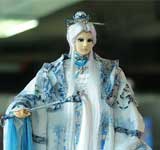| 鍙岃锛氫綘鏄伐浣滅媯鍚?绉戝娴嬭瘯甯綘閴村畾 | |
http://english.dbw.cn銆€銆€
2012-05-15 11:28:58
|
|
|
As BlackBerries and global business mean more and more of us work 'out of hours', addiction to work is becoming more common. But until now, being a 'workaholic' has been a matter of opinion - much in the same way as Dylan Thomas quipped, 'An alcoholic is someone you don't like who drinks as much as you do.' Now, Norwegian scientists have designed a 'scale' to separate out keen workers from those who have a behavioural problem that drives them to harm themselves by overwork. The ‘Bergen Work Addiction Scale’ looks at the kind of behaviour that is displayed by all kinds of addicts, from drug users to alcoholics, but related to the workplace. Those who, for instance, free up time to fit in extra work or feel guilty if they don’t stay late on a regular basis may be workaholics. Reporting to the Journal of Psychology, researcher Doctor Cecilie Schou Andreassen of the Univesity of Bergen, said the Scale was the first of its kind in the world. It was tested on 12,000 workers from 25 different kinds of industry, and reflects what she called the ‘seven core elements of addiction.’ These are salience - noticeability - mood, tolerance, withdrawal, conflict, relapse and problems. The Scale was designed jointly by psychologists from Norway’s University of Bergen with colleagues from Nottingham Trent University. The Bergen scientists believe work addiction is getting worse, not better, because the boundaries between home and office are getting blurred. Being in constant touch through mobile phones and laptops and tablet computers, for instance, means it is harder to ‘switch off’ and easier to work from home. Growing globalisation also means it necessary for some companies to be in touch with colleagues in different time zones, so it will happen outside normal working hours. These factors, and others, contribute to more employees who are ‘driven to work excessively and compulsively’ - the definition of an addict. Are you a workaholic? The test that finds out if you have a problem Look at each of the following statements and rank yourself on each one according to the following: 1 = Never; 2 = Rarely; 3 = Sometimes; 4 = Often; 5 = Always. You think of how you can free up more time to work. You spend much more time working than initially intended. You work in order to reduce feelings of guilt, anxiety, helplessness and depression. You have been told by others to cut down on work without listening to them. You become stressed if you are prohibited from working. You deprioritize hobbies, leisure activities, and exercise because of your work. You work so much that it has negatively influenced your health. If you score ‘often (4)’ or ‘always (5)’ on four or more of these seven statements, it ‘may suggest you are a workaholic.’ 榛戣帗鎵嬫満鍜岃法鍥借锤鏄撴剰鍛崇潃瓒婃潵瓒婂鐨勪汉瓒呮椂宸ヤ綔锛屽伐浣滅媯鐜拌薄鍙樺緱瓒婃潵瓒婃櫘閬嶃€?/span> 鍒扮幇浠婁负姝紝“宸ヤ綔鐙?rdquo;浠嶆槸瑙佷粊瑙佹櫤鐨勪竴涓瘽棰橈紝鐙勫叞•鎵橀┈鏂閰掗鐨勫畾涔変篃鏄姝わ紝浠栨浘鎵撹叮璇达細“鍡滈厭鑰呭氨鏄枬閰掑枬寰楀拰浣犱竴鏍峰鐨勮鍘岄銆?rdquo; 鐜板湪锛屾尓濞佺瀛﹀璁捐浜嗕竴涓?ldquo;灏哄害琛?rdquo;锛屽皢绉瀬鐨勫憳宸ュ拰閭d簺鏈夎涓洪棶棰樸€佸伐浣滆繃搴︿互鑷充激韬殑鍛樺伐鍖哄垎寮€鏉ャ€?/span> 杩欎竴“鍗戝皵鏍瑰伐浣滅媯灏哄害琛?rdquo;瑙傚療浜嗕粠鍚告瘨鑰呭埌鍡滈厭鑰呯瓑鍚勭鐦惧悰瀛愮殑琛屼负琛ㄧ幇锛屼絾鏄皢杩欎簺琛屼负鍜岃亴鍦鸿仈绯昏捣鏉ャ€?/span> 涓句緥鏉ヨ锛岄偅浜涜吘鍑烘椂闂村姞鐝垨鏄鏋滀笉澶╁ぉ瓒呮椂宸ヤ綔灏变細鎰熷埌鍐呯枤鐨勪汉鍙兘鏄伐浣滅媯銆?/span> 鐮旂┒浜哄憳銆佸崙灏旀牴澶у鐨勫瑗胯帀浜?bull;浼?bull;瀹夊痉鐟炰簹妫崥澹璇ュ昂搴﹁〃鍦ㄥ叏涓栫晫鏄ご涓€涓€傝繖涓€鐮旂┒鍙戣〃鍦ㄣ€婂績鐞嗗鏉傚織銆嬩笂銆?/span> 杩欎釜琛ㄧ粡杩?5涓涓氱殑1.2涓囧悕鍛樺伐鐨勬祴璇曪紝鍙嶆槧鍑哄畨寰风憺浜氭.鍗氬+鎵€璇寸殑“涓婄樉鐨勪竷涓绱?rdquo;銆?/span> 杩欎簺瑕佺礌鏄細绐佸嚭鎬э紙鏄捐憲鎬э級銆佹儏缁€佸繊鑰愬姏銆佽劚鐦俱€佹專鎵庛€佸鍙戙€侀棶棰樸€?/span> 璇ヨ〃鏄尓濞佸崙灏旀牴澶у鐨勫績鐞嗗瀹跺拰璇轰竵姹夌壒浼︾壒澶у鐨勫悓浜嬪叡鍚岃璁$殑銆?/span> 鍗戝皵鏍瑰ぇ瀛︾殑绉戝瀹惰涓轰汉浠殑宸ヤ綔鎴愮樉鐥囨棩鐩婁弗閲嶏紝鍥犱负瀹跺涵鍜屽姙鍏鐨勭晫闄愯秺鏉ヨ秺妯$硦銆?/span> 渚嬪锛岀粡甯镐娇鐢ㄦ墜鏈恒€佺瑪璁版湰鐢佃剳鍜屽钩鏉跨數鑴戞剰鍛崇潃鏇撮毦“鍏虫満”锛屼篃鏇村鏄撳湪瀹跺伐浣溿€?/span> 鍏ㄧ悆鍖栫殑鍙戝睍涔熸剰鍛崇潃鏌愪簺鍏徃闇€瑕佸拰涓嶅悓鏃跺尯鐨勫悓浜嬭仈绯伙紝鍥犳浜轰滑涔熶細鍦ㄩ潪姝e父宸ヤ綔鏃堕棿宸ヤ綔銆?/span> 杩欎簺鍥犵礌鍜屽叾浠栧洜绱犺鏇村鐨勫憳宸?ldquo;涓嶅緱涓嶅己杩€у湴宸ヤ綔杩囧害”——杩欐瀯鎴愪簡宸ヤ綔鎴愮樉銆?/span> 娴嬩竴娴嬩綘鏄笉鏄伐浣滅媯 闃呰涓嬮潰鐨勯檲杩帮紝骞舵寜濡備笅鍑犵被缁欒嚜宸辨墦鍒嗭細1銆佷粠涓嶏紱2銆佸緢灏戯紱3銆佹湁鏃讹紱4銆佺粡甯革紱5銆佹€绘槸銆?/span> 浣犳€濊€冨浣曡兘鑵惧嚭鏇村鏃堕棿鏉ュ伐浣溿€?/span> 浣犲伐浣滅殑鏃堕棿姣斾綘棰勬兂鐨勫寰楀銆?/span> 浣犱负浜嗗噺灏戝唴鐤氭劅銆佺劍铏戞劅銆佹棤鍔╂劅鍜屾姂閮佹劅鑰屽伐浣溿€?/span> 鍒汉璁╀綘鍑忓皯宸ヤ綔閲忥紝浣嗕綘缃嫢缃旈椈銆?/span> 濡傛灉浣犺绂佹宸ヤ綔锛屼綘浼氭劅鍒板帇鍔涘緢澶с€?/span> 浣犺宸ヤ綔浼樺厛浜庝綘鐨勭埍濂姐€佷紤闂叉椿鍔ㄥ拰鍋ヨ韩銆?/span> 浣犲伐浣滃お澶氾紝宸茬粡瀵逛綘鐨勫仴搴烽€犳垚璐熼潰褰卞搷銆?/span> 濡傛灉杩?椤归檲杩颁腑锛屼綘鏈?椤逛互涓婃槸“缁忓父”鎴?“鎬绘槸”锛岄偅涔堣繖“鍙兘鎰忓懗鐫€浣犳槸涓伐浣滅媯”銆?/span> |
|
| Author锛? 銆€銆€銆€Source锛? China Daily 銆€銆€銆€ Editor锛? Wu Qiong | |
 涓枃绠€浣?/a>銆€|銆€
涓枃绠€浣?/a>銆€|銆€










